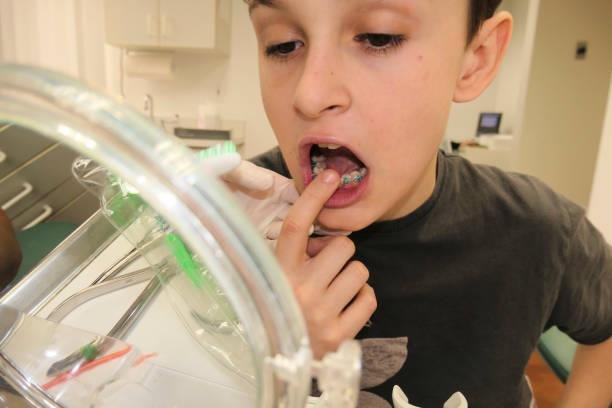Active kids have endless energy. This can cause accidents, including chipped teeth. Children with chipped teeth may experience pain and oral health issues. Modern dentistry can fix chipped teeth and keep your smile healthy. This article will explore the different types of child-chipped front tooth repair available for children, discuss preventive measures, and provide guidance on finding the best dentist for your child’s dental restoration needs. Broken enamel creates chipped teeth. Children chip teeth from falls, sports injuries, and intricate bites. Chipped teeth can hurt kids and harm their teeth. Treat chipped teeth immediately.
Preventing Chipped Teeth in Children
Prevention is key when it comes to maintaining children’s dental health. Here are some practical tips to help prevent chipped teeth:
- Use mouthguards during sports activities to protect teeth from potential impact.
- Encourage children to avoid chewing on hard objects like ice, pens, or popcorn kernels.
- Teach children proper oral hygiene habits, including regular brushing and flossing, to keep teeth strong and healthy.
- Supervise playtime activities to minimize the risk of falls and accidents.
- Schedule regular dental check-ups to identify and address potential dental issues before they worsen.
Types of Dental Restorations for Children
When restoring chipped teeth in children, dentists employ various techniques based on the severity of the damage. Here are some common types of dental restorations:
Dental Bonding
Dental bonding repairs chipped teeth with tooth-colored resin. To match the natural tooth, the resin is molded and polished. Dental bonding repairs minor chipped teeth quickly and painlessly.
Veneers
Porcelain or composite veneers cover teeth. They are custom-fitted to cover the chipped tooth’s front surface, improving its appearance. Veneers are popular for larger chips or fractures.
Dental Crowns
Crowns entirely cover broken teeth. They’re used for significant chipping or tooth damage. Dental crowns restore function and appearance.
Dental Fillings
Fillings are utilized for minor to major tooth chips. The injured tooth is extracted and filled with composite resin or amalgam. Dental fillings repair, protect, and keep teeth.
Importance of Early Dental Restoration
Chipped teeth in children must be addressed early. First, early restoration stops the chipped area from developing bacteria, minimizing infection risk. Restoring chipped teeth improves dental health by aligning and biting properly. Early dental restoration can help improve a child’s speech and self-esteem.
Importance of Professional Treatment

Your child’s chipped tooth needs professional treatment, even if it doesn’t hurt. Professional dental repair improves the tooth’s appearance, function, and health. A qualified dentist, like the pediatric dentist from Frisco, Texas, will evaluate the extent of the damage and recommend the most suitable restoration option for your child.
Finding the Best Dentist for Children’s Dental Restoration
Choosing the right dentist for your child’s dental restoration is vital. Consider the following factors when searching for a dentist:
- Look for a pediatric dentist experienced in treating children.
- Ensure the dental practice is child-friendly and creates a comfortable environment.
- Seek recommendations from friends, family, or trusted healthcare professionals.
- Research online reviews and testimonials to gauge the dentist’s reputation.
- Schedule a consultation to discuss your child’s specific needs and ask any questions you may have.
Remember, a positive dental experience at a young age sets the foundation for a lifetime of good oral health habits.
The Role of Parents in Children’s Dental Health
Parents play a critical role in maintaining their children’s dental health. Here are a few tips to promote healthy teeth in children:
- Lead by example and demonstrate good oral hygiene practices.
- Encourage healthy eating habits, emphasizing the importance of a balanced diet.
- Monitor brushing and flossing routines to ensure proper technique and consistency.
- Schedule regular dental check-ups and follow the dentist’s recommendations for preventive care.
- Teach children about the potential risks of chewing on hard objects or engaging in unsafe activities.
Parents can help prevent chipped teeth and other oral health issues by actively participating in their children’s dental care.
Tips for Maintaining Healthy Teeth in Children
Aside from preventive measures and dental restorations, there are several additional tips for maintaining healthy teeth in children:
- Limit sugary snacks and beverages, as they can contribute to tooth decay.
- Encourage drinking water, which helps wash away food particles and maintain saliva production.
- Promote regular brushing and flossing to remove plaque and prevent cavities.
- Consider dental sealants, which act as protective coatings for the back teeth, reducing the risk of decay.
- Schedule routine dental cleanings to remove tartar buildup and detect early signs of dental problems.
Remember, a comprehensive approach to oral health involves a combination of preventive care, regular check-ups, and healthy habits at home.
Aftercare and Oral Hygiene Tips
After the dental restoration, it’s crucial to maintain proper oral hygiene and follow the dentist’s instructions. Here are some aftercare tips:
- Please encourage your child to brush their teeth twice daily with fluoride.
- Teach them how to floss correctly to remove plaque and debris.
- Schedule regular dental check-ups to monitor the restoration and overall oral health.
- Avoid hard and sticky foods that may damage the repair.
Final Thoughts
Children’s dental health depends on pediatric dentistry chipped tooth remedies. Accidents happen, and chipped teeth can hurt kids. Modern dentistry includes bonding, veneers, crowns, and fillings to restore damaged teeth in youngsters. To avoid further issues, treat chipped teeth immediately. Preventing chipped teeth requires mouthguards, good oral hygiene, and regular dental visits. Frisco, Texas, pediatric dentists provide the best dental restoration for children. Leading by example, monitoring oral hygiene, and arranging regular checkups help parents maintain their children’s dental health. Children can have lifetime smiles with proper maintenance.
















